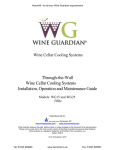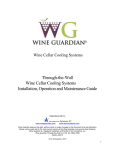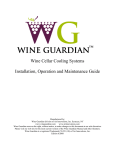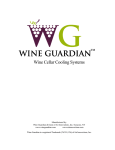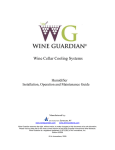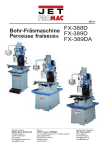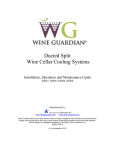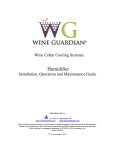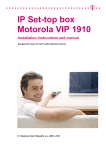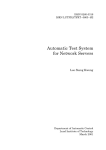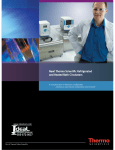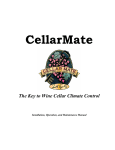Download Wine Guardian Through-the-Wall Specifications
Transcript
Through-the-Wall Wine Cellar Cooling Systems Installation, Operation and Maintenance Guide Manufactured by: WineGuardian An Air Innovations Company North Syracuse, NY USA www.wineguardian.com www.airinnovations.com Wine Guardian is a registered Trademark (76/551,126) of Air Innovations, Inc. Table of Contents Table of Contents Introduction ............................................................................................................ 2 Receiving, Inspecting and Unpacking the Wine Guardian Unit ...................... 3 Receiving and Inspecting the System ........................................................................................... 3 Reviewing the Packing Slip ......................................................................................................... 3 Checking the System .................................................................................................................. 3 General Description ............................................................................................... 4 Wine Guardian Control ............................................................................................................... 5 Wine Guardian Control Illustration ......................................................................................... 6 Standard Specifications ......................................................................................................... 7 Accessories and Optional Equipment .......................................................................................... 8 Overview of the Wine Guardian System ...................................................................................... 9 Overview of the System ................................................................................................ 10 Specifications Illustration ............................................................................................ 10A Safety ..................................................................................................................... 11 Safety Message Conventions .................................................................................................... 11 Danger .............................................................................................................................. 11 Warning .............................................................................................................................. 11 Caution .............................................................................................................................. 11 Lockout/Tagout Procedure ....................................................................................................... 12 Safety Considerations ............................................................................................................... 12 Safety Hazards ......................................................................................................................... 12 Electrical Hazards .............................................................................................................. 12 Electrical Shock Hazards .............................................................................................. 12 Hot Parts Hazards .............................................................................................................. 12 Moving Parts Hazards ........................................................................................................ 13 Equipment Safety Interlocks ...................................................................................................... 13 On/Off Switch ......................................................................................................................... 13 Installation ............................................................................................................ 15 Planning the Installation ............................................................................................................. 16 Addressing Items in the Planning Process ............................................................................ 16 Performing a Pre-installation Check .................................................................................... 17 Locating the System ............................................................................................................ 17 Grilles ................................................................................................................................. 17 Mounting the System ..................................................................................................... 17-19 Installing the Condensate Overflow ..................................................................................... 20 Installing the Drain Line ................................................................................................. 20 Priming the Drain Trap .................................................................................................. 21 Wiring the Unit for Power ................................................................................................... 21 Starting-up and Operating the Wine Guardian ................................................................. 21-22 Turn on the System ................................................................................................................... 23 i Wine GuardianTM User Manual Configuration Settings ............................................................................................................... 21 Settings 1 - 19 ..................................................................................................................... 24-26 Testing the Fan ......................................................................................................................... 27 Running the System ................................................................................................................... 27 Cycling the System ................................................................................................................... 27 Setting the Thermostat ............................................................................................................. 27 Regulating the Wine Cellar Temperature .................................................................................... 27 Changing the Air Flow Direction ................................................................................................ 27 Maintenance ......................................................................................................... 28 General .................................................................................................................................... 28 Maintenance Schedule .............................................................................................................. 29 Monthly .............................................................................................................................. 29 Yearly ................................................................................................................................. 29 High Pressure Switch has shut the Unit Down ...................................................................... 30 Troubleshooting.................................................................................................... 31 Typical Start-up Problems ......................................................................................................... 31 Unit Does Not Start-up ............................................................................................................ 32 Thermostat Light is Off ................................................................................................. 32 Thermostat Light is On ................................................................................................. 32 Unit is Operating and Blows Evaporator Air, but the Supply Air ................................................ 33 Cellar Temperature is Too Low when System is Running ...................................................... 33 Cellar Temperature is Too Cold when System is Not Running .............................................. 33 Cellar Temperature is Too High, but Supply Air is Cold ....................................................... 33 Cellar Humidity ......................................................................................................................... 34 Humidity Too Low or Supply Air is Too Cold, Without Optional Humidifier ......................... 34 Humidity Too Low and Without Optional Humidifier ............................................................ 34 Humidity Too Low and With Optional Humidifier ................................................................. 34 Humidity Too High When System is Running But Not Cooling ............................................ 35 Humidity Too High When System is Not Running ............................................................... 35 Humidity Too High When System is Running and Cooling .................................................... 35 System is Leaking Water ..................................................................................................... 35 System is Running Properly, but the Sound of Unit is Objectionable ................................... 35 Wine Guardian Warranty ..................................................................................................... 36 ii Introduction Dear Customer, Congratulations and thank you for purchasing a Wine Guardian cooling system. We believe it to be the best wine cellar cooling system on the market and hope that you will agree. This guide is intended to help the installer and owner of the Wine Guardian cooling system to properly install and maintain the equipment. In order to ensure a long and trouble-free operation, please read this manual carefully, especially the safety instructions, and keep it for future reference. IMPORTANT! Customer Warranty Registration PLEASE COMPLETE AND RETURN IMMEDIATELY TO REGISTER THE WARRANTY ON YOUR NEW WINE GUARDIAN AND ACCESSORIES Wine Guardian’s Consumer Protection Program Please complete and return this Product Registration Card along with copies of your original purchase receipts within ten days from date of sale to enroll in Wine Guardian’s Consumer Protection Program. Note: The Product Registration Card is included in the system’s packaging. By registering your purchase, you will automatically be enrolled. Our Consumer Protection Program provides you with the following √ New Product Announcements: so you can be kept informed of the latest Wine Guardian products and accessories. √ Product Safety Notification: registering your product allows us to contact you in the unlikely event a product safety notification or service bulletin is issued. √ Confirmation of Ownership: we keep the model number, serial number, and other information on this card in our files up to ten years. In the event of fire, flood or theft, your registration serves as your proof of purchase for insurance purposes. √ Warranty Service: filling out Product Registration Card helps you obtain efficient warranty service. 2 Receiving, Inspecting and Unpacking the Wine Guardian System Receiving and Inspecting the System NOTE Wine Guardian systems are factory assembled and tested prior to shipment. Wine Guardian systems are shipped individually in corrugated boxes specially designed to protect the equipment during shipment. √ Before opening the container, inspect the packing crates or boxes for obvious signs of damage or mishandling. √ Write any discrepancy or visual damage on the bill of lading before signing. √ Inspect all equipment for any sign of damage caused during transit. √ Report all visual or concealed damage to the carrier and file a claim immediately. If this procedure is not followed, the shipping company may reject the claim and the consignee may suffer the loss. Do not return the shipment to the factory. IMPORTANT ** DO NOT LIFT THE UNIT UP FROM ITS PLASTIC FRONT PIECES TO AVOID DAMAGING THEM The system should be lifted form underneath its base at both ends of the system. Review the Packing Slip to Verify: √ Model number √ Factory-installed options √ System accessories If any items listed on the packing slip do not match your order information, contact the place of purchase immediately. Check the unit for: √ An electrical power cord (factory installed on condenser side) √ The Through-the-Wall mounting sleeve √ Accessories such as condenser air duct collar or duct collar kit, and optional controls, if ordered 3 General Description View the Overview Illustration located on page The Through-the-Wall Wine Guardian cooling system is a professional grade, self-contained climate control system designed specifically for the storage of wine at cellar temperatures. It is designed for easy installation and operation. Wine Guardian uses digital electronic controls and environmentally friendly R-134a refrigerant. The entire system is run-tested at the factory and shipped as a single package. All components are of a high quality standard commercial grade. The entire system is approved by ETL (Equipment Testing Lab) according to UL (Underwriters Laboratory) 484 and CSA (Canadian Standards Association) safety standards. All wiring complies with NEC (National Electrical Code). Each system is factory installed with a sealed, UL-approved power cord and plug, that can be mounted on either end of the cooling system. Wine Guardian products are made in the USA. The Wine Guardian Through-the-Wall system is completely self-contained and includes an integral air cooled condenser. The system is functionally divided into two sections, the evaporator or cooling section, and the condenser or heat rejection section. Each section contains a coil to add or remove heat and a fan to move the air through the coil and into or out of the cellar or adjacent space. Air from the cellar first enters the cooling coil. Air passes through the cooling coil and is cooled by the refrigerant inside the coil. This causes any excess humidity in the air to condense and be captured in the drain pan and internally evaporates as it comes in contact with the integral condensate removal coil. Air then enters the fan where it is pressurized and discharged out of the system. The thermostat, located on the system, or through the optional remote interface controller, turns the cooling on and off as needed to maintain its set point. The compressor and condenser section are activated whenever the system is cooling. The condenser fan draws air from the surrounding or ambient space. The air flows through the condenser coil where it absorbs heat from the refrigerant in the coil. The air is finally discharged out of the system by the condenser fan, and can be ducted ouside or to an unused space by an optional condenser duct kit. CAUTION The air exhaust from the condenser fan is warm and can be 20 degrees F above the entering air temperature. 4 Wine Guardian Controls Wine Guardian’s digital electronic control series offers a versatile solution for controlling and monitoring your wine cellar temperature and humidity. This series consists of four controls; a main control board; a local user interface; a remote user interface; and a remote temperature and humidity sensor. The system only requires the use of the main control board and one of the user interfaces (local or remote) to function. However, users have the following options to customize the control capabilities for their application: (See page 6 for description of control boards and optional sensors). The Wine Guardian’s digital electronic controls are designed to control the operation of the compressor, condenser fan, evaporator fan, and humidifier. There also is pressure switch monitoring with a dry contact alarm output that will energize in the event of a pressure switch fault or a high/low temperature or humidity alarm. The local and remote user interface controls employ user-friendly, menu-driven programming features that can easily be accessed by holding the mode button on the control for 5 seconds. Once in the program menu, the user can scroll through the settings by pressing the mode button and can adjust each setting by using the up and down arrows. The programming mode allows the user to customize features such as °F or °C temperature scale, high/low temperature and humidity alarm set points, an adjustable 0-10 minute compressor anti-short cycle delay, sensor averaging options, enable or disable the defrost feature, an optional keypad lockout code, differential and dead band adjustments, room temperature calibration, enable or disable the humidifier, and automatic or continuous fan option. To exit the programming mode the user may either hold the mode button for 5 seconds or the control will automatically store the settings and exit the programming mode after 10 seconds of inactivity. Each user interface control will also employs and ON/ OFF button that turns the system on or off respectively. 5 Wine Guardian Controls Main Control: Performs all switching functions and interfaces with inputs and outputs. It can connect to local or remote user interface, as well as remote temperature/humidity sensor. Two way communications: local user interface reports settings back to main control, main control energizes outputs and reports alarms and temp/humidity readings to local user interface. One way communication: remote temp/humidity sensor reports temp and humidity readings to main control. Local User Interface: Can be used with Main Control for adjusting settings, reading temp/humidity, and reading fault codes at the unit. Two way communications: remote user interface reports settings back to main control, main control energizes outputs and reports alarms and temp/humidity readings to remote user interface. Remote User Interface: Can be used with Main Control for adjusting settings, reading temp/humidity, and reading fault codes in a remote location away from the unit. Temperature/Humidity Sensor: Can be used in conjunction with the Main Control to report temp/humidity from inside the wine cellar without requiring a user interface to be located inside the wine cellar. 6 Standard Specifications IMPORTANT Design and specifications are subject to change without notice The Wine Guardian System Contains √ A capillary tube expansion to control the flow of refrigerant into the evaporator coil √ A filter dryer to keep the refrigerant clean and free of contaminants √ Dual factory mounted plastic supply/return air grilles for evaporator and condenser air movement √ Movable suply air louvers for side-to-side directing of cold air into the wine cellar √ A manually reset, high-pressure switch on the discharge to protect the compressor from high pressures √ Environmentally friendly R-134a refrigerant √ An internally/externally mounted digital electronic control with many user-controlled settings √ Auxiliary drain port connection at condenser end of unit All exterior framing of the Wine Guardian is powder coated, 0.063" gauge aluminum to prevent rust and corrosion. All coils are copper tubes with aluminum fins. The evaporator is coated with an “E” coat finish to prevent premature corrosion.The system uses an internal drain system to remove excess moisture and not reintroduce it into the cellar or ambient space. An auxiliary drain port is located at the condenser end of the unit should there be a need to physically remove the excessive moisture. Each system is provided with a pre-wired and tested electronic digital thermostat (local user interface) as standard, or an optional remote mounted thermostat (remote user interface) in the cellar. The thermostat has multiple control functions for the fans, cooling and heating (if equipped), and maintaining humidity. Compressors are self-lubricating, permanently sealed, hermetic reciprocating type compressors, with internal overload protection and capacitor start with a minimum of one-year manufacturers warranty and an optional five -year warranty. Compressors are mounted on rubber-in-shear isolators to reduce noise and vibration. Electric power is supplied by a single, factory-furnished cord and plug that can be connected on the cellar side or the condenser side of the system. Systems are shipped from the factory with the plug attached on the condenser side. (to switch plug to the cellar side see page ???of this manual.) All external controls are 24-volt supplied from an internal transformer. 7 Accessories and Optional Equipment Installation Sleeve Each Wine Guardian system includes an EasyMountTM installation sleeve to be used in the mounting of the system through-the-wall at the desired location. The sleeve is essential for the proper support of the Wine Guardian system and ease of installation. The maximum dimensions of the wall opening should be 14-1/2” wide by 16-1/4” high. For proper operation of the system, including drainage and undue noise and vibration, the Installation Sleeve must be mounted level within the wall cutout and securely fastened to the wall studs on either side of the sleeve as shown on page 20. Extended Compressor Warranty The Wine Guardian uses only the best commercially available compressors on the market. However, since the compressor is the single most expensive component in the system, it is recommended that you purchase the extended, five-year warranty option. Duct Collar Adapter An optional duct collar kit is available for ease in directing the warm condenser air away from the through-the-wall unit mounting. The kit includes one (1) duct collar, 15-feet of 6-inches round flexible ductwork and two(2) tie wraps for connection of the ductwork to the duct collar. The kit does not include connections at the tie-in point to the remote location or outdoors. Remote Temperature/Humidity Controller The remote temperature/humidity controller (Remote Interface Controller) is intended to provide a means for user interface at a remote location. The controller can be used as a remote sensor/controller mounted within the wine cellar remote from the Through-the-Wall system. The controller also can be used as a remote controller (without sensor) or indicator mounted directly outside the wine cellar or in another part of the residence or building. The Remote Interface Controller includes a backlit face for temperature and humidity indication along with controller set-up and operational functions. Remote Temperature/Humidity Sensor The remote temperature/humidity sensor is intended to provide a means of sensing one or more locations within the wine cellar and is designed to work in conjunction with the Remote Interface Controller or Local Interface Controller integral to the Wine Guardian Through-the-Wall system. Multiple sensor readings are averaged and controlled to a single point. The sensors do not have any temperature or humidity indication and must be mounted within the wine cellar area being controlled. Humidity Option – An optional stand-alone humidifier comes fully assembled and tested for field installation. It automatically adds moisture into the cellar by the evaporation of water over a distribution pad. 8 Overview of the Wine Guardian Unit Refer to illustrations on page 10 Cabinet – The cabinet is constructed of aluminum with a powder coated finish for corrosion protection and an attractive, maintenance-free appearance. Areas in contact with cold temperatures are lined with insulation to prevent condensation. Condensing Section - Ambient air is circulated through the condenser section by a direct drive, permanently lubricated, motorized impeller blower. This section also contains the compressor and the electrical controls. Evaporator Section – Wine cellar air is circulated through the evaporator section by a direct drive, permanently or lubricated motorized impellar blower. The large evaporator coil face area eliminates condensate carry-over, reduces air pressure drop and optimizes heat transfer. A drain pan is located directly below the coil to capture condensate and is fabricated from aluminum to prevent rust and corrosion. Electrical Controls –All solid state electronic controls are connected internally and/or externally through a phone cord-type connection. There is no need to open the chassis to access the factory mounted and wired control. All internal wiring is in accordance with the National Electrical Code. Wires are numbered and color coded to match the wiring diagrams. Factory Tested – All Wine Guardian systems are factory run-tested and checked for operational performance. Internal Drain Trap – Condensate from the evaporator coil fills the trap and forms a seal to prevent air from being drawn back through the drain tube. This allows the drain pan to drain freely. No external trap is required. Refrigerant Circuit – The factory-charged circuit includes a capillary tube expansion device, a filter dryer, and a manual reset high pressure switch. See Refrigeration Illustration on page Supply/return grilles – These are made of rugged ABS plastic and factory mounted to automatically seal to the chassis. Air is introduced through the sides and bottom and discharged through the front perforated section. Directional Louvers – Two directional louvers are located within the evaporator supply air discharge opening on the Wine Guardian system and can be accessed by removal of the wine cellar side faceplate. The louvers are designed to be manually adjusted to direct air flow from side-to-side or straight on. The louvers can help direct cold air into the center of the wine cellar should the Throughthe-Wall system be mounted in a corner of the room. 9 Overview and back view 10 8 F 7 6 4 5 GRN/WHT TERM EVAP END WHT 181 WHT L2 L1 191 BLK 10 FROM POWER CORD F WHT BRN TERMINAL L2 BLK TERM COND END WHT 171 11 OPTIONAL POWER CORD POSITION E WHT 201 16 EVAP FAN WHT WHT L1 EVAP CAP3 30uF 190 BLK L2 LCDI PLUG 1 2 3 E COND FAN BRN BLK BLK GRN/WHT START CAP1 8uF VOLTAGE SWITCH 10 11 D BLK 15 WHT 13 D START CAP2 8uF 16 12 171 WHT WHT BLK COND CAP4 35uF 170 COMPR WHT BLK WHT 181 190 WHT 201 C C 180 BLK BLK BLK BLK K3 190 BLK B PS B K2 HI PWR BOARD BLK BLK 15 K1 L1 DEF R H PRESS. SWITCH UNLESS OTHERWISE SPECIFIED: DIMENSIONS ARE IN INCHES TOLERANCES: FRACTIONAL 1/16 ANGULAR: MACH 2 BEND 2 TWO PLACE DECIMAL .03 THREE PLACE DECIMAL .015 A 170 BLK BLK 8 7 BLU RED 6 GRN/WHT C 180 BLK TRANS 5 INTERPRET GEOMETRIC TOLERANCING PER: NAME DATE DRAWN X X CHECKED - - ENG APPR. - - MFG APPR. - - --- 3 PART NUMBER 2 XXXXXXX / Floratech 7000 PERFORMANCE DRIVE, SYRACUSE, NY, 13212, 452-7400 TITLE: SCHEMATIC, WIRING 2100 TTW SIZE DWG. NO. C FINISH 4 Cleanroom Systems MATERIAL COMMENTS DO NOT SCALE DRAWING AiR INNOVATIONS 36H0035-00 REV SHEET 1 OF 1 SCALE: 1:1 WEIGHT: 1 A Safety The following is suggested before installing or maintaining the Wine Guardian System: 1) Read these instructions 2) Keep these instructions 3) Heed all warnings 4) Follow all instructions Safety Message Conventions Safety messages contained in this manual, DANGER, WARNING, and CAUTION are bold and highlighted in red for quick identification. Danger A DANGER message indicates an imminently hazardous situation which, if not avoided, results in death or serious injury. Messages identified by the word DANGER are used sparingly and only for those situations presenting the most serious hazards. Following is a typical example of a DANGER message as it could appear in the manual: DANGER HIGH VOLTAGE - RISK OF SERIOUS INJURY OR DEATH High voltages are present in the cabinets. Before opening panels turn off all power. Use the Lockout/Tagout procedure . Warning A WARNING message indicates a potentially hazardous situation which, if not avoided, could result in death or serious injury. Following is a typical example of a WARNING message as it could appear in the manual: WARNING RISK OF PERSONAL INJURY OR DAMAGE TO EQUIPMENT Modification to the equipment may cause injury. Caution A CAUTION message indicates a potentially hazardous situation which, if not avoided, could result in minor or moderate injury. It may also be used to alert against unsafe practices. 11 Following is a typical example of a CAUTION message as it could appear in the manual: CAUTION RISK OF PERSONAL INJURY OR DAMAGE TO EQUIPMENT Improper installation may result in the equipment malfunctioning and a safety hazard. Read all of the installation instructions before installing the Wine Guardian unit. Lockout/Tagout Procedure 1) Turn the system to off at the local interface controller (the display will indicate the system is off). 2) Unplug the system from the electrical outlet and cover the outlet to prevent accidently plugging in the system. Safety Considerations The equipment covered by this manual is designed for safe and reliable operation when installed and operated within its designed specifications. To avoid personal injury or damage to equipment or property when installing or operating this equipment, it is essential that qualified, experienced personnel perform these functions using good judgement and safe practices. See the following cautionary statements. Installation and maintenance of this equipment is to be performed only by qualified personnel who are familiar with local codes and regulations, and are experienced with this type of equipment. Safety Hazards Exposure to safety hazards is limited to maintenance personnel working in and around the system. When performing maintenance, always use the Lockout/Tagout procedure, which is described in this chapter. Observe the maintenance safety guidelines in the Wine Guardian Manual. IMPORTANT The equipment described in this manual uses electricity. When using this equipment, be sure to follow the safety procedures outlined in the Wine Guardian manual. Electrical Hazards Working on the equipment may involve exposure to dangerously high voltage. Make sure you are aware of the level of electrical hazard when working on the system. Observe all electrical warning labels on the system. Electrical Shock Hazards All power must be disconnected prior to installation and servicing this equipment. More than one source of power may be present. Disconnect all power sources to avoid electrocution or shock injuries. Hot Parts Hazards Electric Resistance heating elements (if equipped) must be disconnected prior to servicing. Electric heaters may start automatically, disconnect all power and control circuits prior to servicing the system to avoid burns. 12 Moving Parts Hazards The Motor and Blower must be disconnected prior to opening access panels. The motor can start automatically. Disconnect all power and control circuits prior to servicing to avoid serious injuries or possible dismemberment. The fans are free-wheeling after the power is disconnected. Allow the fans to stop completely before servicing the system to avoid cuts or dismemberment. Rotating Fan Blades are present in the Wine Guardian system. Sticking a hand into an exposed fan while under power could result in serious injury. Be sure to use the Lockout/Tagout procedure when working in this area or remove the power cord. Equipment Safety Interlocks There are no electrical safety lockouts installed within the system. The power cord attached to the control box must be disconnected from the power sources prior to working on any part of the electrical system. On/Off Switch To shut down all high volt power internally, the power cord must be removed from power outlet. Energy Type Voltage Hazard........................Electrocution, electrical burns and shock Magnitude..................120 Vac and 230 Vac, 1 phase, 60 cycles Control Method...........Disconnect power cord and On/Off Switch DANGERS • Never reach into the system while the fan is running. • Avoid risk of fire or electric shock. Do not expose the system to rain or moisture. WARNINGS • All supports for the system must be capable of safely supporting the equipment’s weight and any additional live or dead loads encountered. • All supports for the system must be designed to meet applicable local codes and ordinances. • Do not remove access panels until fan impellers have completely stopped. Pressure developed by moving impellers can cause excessive force against the access panels. • Fan impellers continue to turn (free-wheel) after the power is shut off. 13 CAUTIONS • Do not block any supply or return air opening. Install in accordance with the instructions in the Wine Guardian manual. • Protect the power cord from being walked on or pinched, particularly at the outlet plugs, convenience receptacles, and the point where it exits the system. • Only use attachments/accessories specified by the manufacturer. • Always operate this equipment from a 120 VAC, 1 phase 60 Hz power sources only. • Always ground the outlet to provide adequate protection against voltage surges and built-up static charges (see Section 810 of the National Electric Code). • Refer all servicing to qualified service personnel. Servicing is required when the system has been damaged in any way, such as: √ power supply cord or plug is damaged √ liquid has been spilled or objects have fallen into the system √ the system has been exposed to rain or moisture √ the system does not operate normally √ the system has been dropped. 14 Installation CAUTION SHARP EDGES RISK OF SERIOUS INJURY Sharp edges are present inside the Wine Guardian system. Pre-installation Test Test the system before installing it to check for non-visible shipping damage. To test the system: √ Set the system on the floor or a sturdy level surface √ Plug in the system √ Press the on/off switch, control illuminates. This indicates the system has power. √ The built in timer prevents short cycling and keeps the system from turning on right away. The system comes on and runs as long as the temperature of the space is above the thermostat set point. After several minutes, cold air comes out of the system from the evaporator section side and hot air comes from the condenser section. Listen for any unusual noise or vibration. Air Flow Illustration 15 WARNING RISK OF PERSONAL INJURY OR DAMAGE TO EQUIPMENT Modification to the equipment may cause injury or damage to the equipment. DANGER √ This equipment is heavy. Place the system on the floor or on a level and stable surface that can support the full weight of the system. √ Do not modify the equipment, it may cause damage to the equipment and voids the warranty. √ Never place anything on top of the system. √ Never block or cover any of the openings or outlets of the system. √ Never allow anything to rest on or roll over the power cord. √ Never place the system where the power cord is subject to wear or abuse. √ Do not use extension cords. √ Never overload wall outlets. √ Do not remove or open any cover unless the system is turned off and the power cord is unplugged. √ Use only dedicated power outlet boxes of the correct capacity and configuration for the system model. CAUTION RISK OF PERSONAL INJURY OR DAMAGE TO EQUIPMENT Improper installation may result in the equipment malfunctioning and a safety hazard. Read all of the installation instructions before installing the Wine Guardian system. Planning the Installation Required Tools Addressing Items in the Planning Process √ Where to locate the system? It can be mounted flush with the racking or flush with the wall on the wine cellar side. √ How to mount the system? A mounting kit is supplied. √ Locate the electrical power outlet close to the system, in cellar or out . Do not use an extension cord! √ Factory supplied power cord on condenser side of the system. It is preferred to be on the condenser side of the system, the cord can be moved to accomodate wine cellar side if need be. 16 √ Does the condenser heat exhaust need to be ducted away? An optional kit is available. √ Where to locate the thermostat, if remote interface control is ordered? Thermostat should be located mid point on a wall within the wine cellar. Provides suffficient access and exposure to airflow from the Wine Guardian system. The thermostat should not be located under shelving or within racking. √ Where to run the overflow drain line? Run to a field supplied drain location or container √ Are all the parts here to complete the installation? Installation sleeve, gasket , sealent, fasteners Performing a Pre-installation Check √ Check for the properly sized breaker as dictated by the system rating plate data. √ Is the cellar built with adequate insulation and vapor barriers? See the Wine Cellar Design Guide at the Wine Guardian’s web site www.wineguardian.com for more information. Locating the System Wine Guardian systems are typically installed at the users eye level for ease of operation. The Throughthe-Wall system discharges warm air from its condenser end so this should be considered when determining the location for the system. Locating the system adjacent to a mechanical room or in close proximity to an exterior wall may be required if ducting the warm condenser air is being considered. The warmer condenser air can be ducted up to15 feet away. Power Cord Location As previously noted, the power cord is factory wired on the condenser side of the system. If you require the cord on the wine cellar side for plugging into an available outlet, this can be accomplished by removing the 3-wire leads (ground included) and moving the cord with connector to the opposite side control bracket and wire nutting the black and white wires to the factory supplied loads. The wires must have the terminations cut off and stripped first. Then screw the ground lead to the hole supplied in the control bracket. You must then move the voltage switch in the opposite direction as from the factory to move the internal power to the cord on the wine cellar side.(See Illustrations) Grilles Factory supplied and installed for proper air intake and discharge for optimal system performance. Mounting the System Follow the steps on the following pages for installation of the Wine Guardian Through-the-Wall system a “new” wine cellar installation. 17 Step 1 Find wall stud locations. If both wine cellar side and finished basement side of walls have drywall already installed it is important to locate the wall studs in the area chosen to mount the Through-theWall system. Use of any high quality stud finder is recommended for locating the center and edges of the wall studs on the wine cellar wall. Once located, the stud edges should be clearly marked prior to following Step 2 below. Step 2 Preparing wall penetration for Installation Sleeve. Mark the penetration dimensions on the wall (wine cellar and finished basement side) at the desired mounting location for the Wine Guardian Throughthe-Wall system. Keep in mind the ideal height should be at eye level to the user. The unit controls should be reachable upon installation completion. The wall penetration should be no nore than 14-1/2” wide by 16-1/4” high stud-to-stud dimension so modifying stud locations is not required. CAUTION RISK OF PERSONAL INJURY OR DAMAGE TO EQUIPMENT Ensure that the area chosen does not have electrical or plumbing interference within the wall or along the outside of the wall. Failure to do so could cause property damage or perosnal injury. If the wall does include electrical wiring or plumbing DO NOT CONTINUE. Contact a qualified electrician or plumber to relocate these services or choose an alternate location for mounting the WG system. Step 3 Slide the EasyMountTM sleeve through the wall penetration so that the flanged area of the sleeve sits flush with the surface of the wall. Ensure the EasyMountTM sleeve is level and plumb prior to fastening to the existing studs. IMPORTANT The Installation Sleeve must be installed level within the wall opening to provide proper operation of the Wine Guardian system. Failure to do so may result in improper drainage, excessive ware, vibration and noise. Caution RISK OF PERSONAL INJURY OR DAMAGE TO EQUIPMENT Flange side of the sleeve must be mounted on side of wall you intend to have the WG flush mounted. 18 Step 4 Fasten the EasyMountTM sleeve to the wall studs through the six (6) pre-drilled holes located on either side of the EasyMountTM sleeve. Starting at location (1) insert a wood screw into the pre-drilled hole and tighten the screw until it is snug. Do no over tighten. Continue to the number (2) Through (6) positions and tighten until all are snug. Do not over tighten. Once each screw has been installed repeat the progression (1) through (6) so that each screw is tight. Ensure screws are inserted flush with wall sleeve inside surface. Step 5 Slide the Wine Guardian Through-the-Wall system through the EasyMountTM sleeve to the desired depth.lease note the Through-the-Wall system must be slid so that the power cord side is last, not first, to enter the sleeve. Do not slide the system past the desired flush mounting point. 19 Step 6 Seal joint between EasyMountTM sleeve and Wine Guardian system on the flange side of system with bulb weather strip seal material provided, to ensure a tight seal and prevent the system from horizontal movement. Installing the Condensate Overflow Condensate generation is a natural by-product of air conditioning systems. The Wine Guardian cooling coils are designed with the understanding that optimal wine cellar humidity levels are between 55% RH and 70%RH. If the vapor barrier of the wine cellar is poorly constructed or excessive moisture is in the basement or surrounding area then the cooling coil may generate excessive amounts of moisture. The condensate will appear in the form of water at the cooling coil drain pan and eventually will travel to the board condensate removal system located below the compressor. The Wine Guardian system features an auxiliary drainport connection located at the condenser end of the system directly below the plastic face plate. In the event of excessive moisture we recommmend connecting the drainport as indicated below. Installing the Drain Line √ The drain line must extend from the system to an external drain or disposal site. Do not use drain tubing any smaller than 1/4 inch inside dimension on the system. √ If no floor drain is available, use a bucket. Do not extend the drain below the rim of the bucket. Empty the bucket periodically. Allow enough height for the drain line to function properly. If draining into a nearby sink, the system must be elevated higher than the rim of the sink in order for the water to drain by gravity. Install with a ¼ inch per linear foot of pitch. See Accessories and Optional Equipment section for information about the condensate pump. 20 Priming the Drain Trap The internal drain trap primes itself automatically once the unit has run for a period of time and after the system cycles off. This is confirmed by water dripping from the drain. Wiring the System for Power WARNING ELECTRICAL SHOCK HAZARD The electrical outlet and wiring installation must meet the national and local building codes. DO: √ Match the electrical outlet to the plug provided on the Wine Guardian. √ Provide dedicated circuit and wiring for the system. √ Match the wiring and breaker size to the rated load as shown on the serial plate and in this guide. See Sample Serial Plate illustration below. DO NOT: √ DO NOT MODIFY THE PLUGS IN ANY WAY! √ Do not use extension cords. IMPORTANT The electrical power supply must be 115 volt AC 1 phase 60 cycle, depending on the model of the system, and cannot vary more than +/- 4% or damage may occur to the system. Plug the system into the wall outlet. Gently pull on the plug to make sure it is tight. 21 Electrical Plug Configuration To comply with the UL STD 484 this system contains a factory supplied LCDI (leakage current detection interruptor) power cord, which specifies that single phase portable air conditioning units contain a porotection device to reduce the risk of an arc fault occuring in the power cord. These provide a reliable way to prevent the risk of fire due to a damaged power cord. They feature electronic detection to automatically cut off power to the unit when a current leakage condition is detected in the systems power cord. Once power is shut off, the device will not be able to be reset until the unsafe current leakage situation is resolved. Power is restores by the “reset” button on the cord’s power head. 22 Control Options and Wiring Each Wine Guardian system comes with a control mounted on front of system. It is wired at the factory for testing prior to shipment. Previously described in this manual. Note Keep the thermostat guide in a folder along with the Wine Guardian Manual for future reference. Remote Thermostat (Optional) A phone cord-style communication cable is required to connect back to port supplied on the main chassis. This may be factory supplied. Mount the thermostat on a solid surface away from doors, corners, air outlets, drafts or heat generating equipment. Do not mount the thermostat directly on an outside wall or wall adjacent to a boiler room. Use a piece of foam insulation behind the thermostat to insulate it from a hot or cold surface. The recommended height is 4 feet to 5 feet above the floor. Remote Temperature/Humidity Sensor Previously described operation. This is also connected to the Wine Guardian chassis via a phone cordstyle cable, which may be factory supplied. Starting-up and Operating the Wine Guardian Control Settings The control has been wired and set up in the factory for testing with default settings. It is an electronic digital thermostat for one-stage cooling. No additional adjustments should be necessary except adjusting the cellar temperature to your preference. If additional adjustments or changes are necessary, please refer to the configuration settings section in this manual. 23 Turn on the System Plug in the system. Touch the on/off bottom on front panel. The display lights up to indicate power to the system. The system may not come on right away due to the timer built into the circuiting toprevent short-cycling. There is a 5-minute compressor/condenser fan time delay on initial start-up. On/Off - The On/Off button will be used to turn the system on or off. When set to the off mode the control will not allow any of the outputs to energize effectively locking the system out. It will not allow any outputs to energize until the system is turn on with the on/off button. It should be noted that high voltage will still be present at the main control board when the system is set to off even though the control will not allow it to switch to the outputs. Up Arrow - The Up arrow will allow the user to increase settings. Down Arrow - The Down arrow will allow the user to decrease settings. Mode - The mode button will be used to select between heat and cool mode, as well as entering the configuration settings. Holding the Mode button for 5 seconds will enter configuration mode. Once in configuration mode the user can adjust settings by pressing the Up or Down arrows. Pressing the Mode button once will advance to the next configuration setting. Holding the Mode button for 5 seconds while in configuration mode will store all changes and exit configuration mode. . Configuration Settings Setting 1 Setting 1 will allow the user to select the Fahrenheit or Celsius temperature scale. It will toggle between F and C when the Up or Down arrows are pressed. The default is F. 24 Setting 2 Setting 2 is the low temperature alarm set point. The minimum setting for this feature will be 30°F. There must be at least 4°F difference between the low and high temperture alarm set points and at least a 2°F difference between the actual temperture set point and the alarm set point. Default setting is 50°F. Setting 3 Setting 3 is the high temperature alarm set point. The maximum setting for this feature will be 100°F. There must be at least a 4°F difference between the low and high temperature alarm set points and at least a 2°F difference between the actual temperature set point and the alarm set point. Default setting is 60°F. Setting 4 Setting 4 is the low humidity alarm set point. The minimum setting for this feature is 5%RH. There must be at least a 4%RH difference between the low and high humidity alarm set points and at least a 2%RH difference between the actual humidity set point and the alarm set point. Default is 5%. Setting 5 Setting 5 is the high humidity alarm set point. The maximum setting for this feature is 95%RH. There must be at lest a4%RH difference between the low and high humidity alarm set points and at least a 2%RH difference between the actual humidity set point and the alarm set point. Default is 95% . Setting 6 Setting 6 is the service menu code screen. The user will be required to enter a code to access any further features. The purpose of this is to prevent homeowners from tampering with vital system setting that they may not understand. They will be required to type in the fixed three-digit code of 212 in order to access any further features. Setting 7 Setting 7 is the adjustable anti-short cycle delay for the compressor. It will be adjustable from 0-10 minutes in 1 minute increments. The default is 5 minutes. Setting 8 Setting 8 allowsl allow the user to select the type of interface they will be using (local or remote) and whether they will be averaging the sensors or using one as the primary sensor. The default will be local user interface. Setting 9 Setting 9 allows the user to enable or disable the defrost sensor input. Note: This feature will be locked out for Wine Guardian. Setting 10 Setting 10 is the defrost cut in temperature. This setting will be adjustable from 25°F to 40°F. Default will be 39°F. There must be at least a 1°F difference between defrost cut in and cut out set points. Note: This feature will be locked out for Wine Guardian. 25 Setting 11 Setting 11 is the defrost cut out temperature. This setting will be adjustable from 35°F to 50°F. Default will be 40°F. There must be at least a 1°F difference between defrost cut in and cut out set points. Note: This feature will be locked out for Wine Guardian. Setting 12 Setting 12 is the compressor run time setting for defrost. It will be adjustable from 1 to 12 hours in 1 hour increments. Default will be 4 hours. Note: This feature will be locked out for Wine Guardian. Setting 13 Setting 13 is the room sensor calibration. This setting will allow the user to adjust the room temperature reading by +/-5°F. Default setting will be 0°F. Setting 14 Setting 14 is the differential temperature adjustment. This setting will allow the user to adjust the turn on differential from 1°F to 3°F (the turn off differential is fixed at 1°F). Default is 1°F. Setting 15 Setting 15 is the deadband setting, which is the minimum allowable temperature difference between the heating and cooling set points. This will be adjustable from 1°F to 5°F. Default is 2°F. Setting 16 Setting 16 is the humidifier on/off feature. If set to off, the humidifier output and set point adjustment will be disabled. If set to on, the user will be able to enter a humidity set point in the local user interface and the humidifier output will energize based on that set point. The local user interface will always display the RH% even if this feature is set to off. Setting 17 Setting 17 is the fan auto/on feature. The user will have the option to set the fan operation to auto in which case it will only turn on with a call for heating, cooling, or humidifier. They may also set the fan to on which will run the fan continuously. The default setting will be auto. Setting 18 Setting 18 is the test mode setting. When set to on, the control will automatically turn on all outputs with the exception of electric heat. Default is off. Setting 19 As factory set to Wine Guardian the set temperature range is 32°F -100°F with a default of 55°F, the humidity set range is 10% - 90% with a default of 55%, the default low temperature alarm is 50°F, the default high temperature alarm is 65°F, the default low humidity alarm is 5%, the default high humidity alarm is 95%, the defrost feature is disabled, the control will be default to auto change over mode, and the fan auto/on feature is defaulted to auto. All other settings are to remain as listed above. 26 Testing the Fan Scroll through configurations settings to 17 for “On” or “Auto” operation. It is factory default to “Auto”. • ON means the fan runs continuously and indicates that the power is on and the control circuit is energized and operating. • AUTO means the fan runs only when the thermostat is calling for cooling or humidification. Running the System √ √ Check system to confirm the compressor is running. When the compressor is on, the system will blow cold air to the wine cellar and warm air from the condensor section. Check for any unusual noise or vibration, such as clanking or rubbing. Important: It is normal for the display to read a “high temperture” default alarm upon initial start-up while trying to pull the wine cellar down to operating conditions as factory default is set at 600F and its likely the cellar may be above this condition upon initial start-up in a new application. The system will continue to cool until it gets within 2 % +/- of the set point. Initially, the system may run continuously for several hours, up to a day or more, while it lowers the cellar temperature. Once the system reaches the set point temperature, it shuts off and starts to cycle on and off as it continues to lower the cellar temperature to the set point. The cellar air reaches set point before the bottles. If the cellar temperature started at 750F, the supply air temperature discharged from the system will probably be 15 to 200F colder. As the cellar temperature decreases to 550F, the supply temperature differential decreases 8 to 120F colder. Cycling the System The fans continue to free-wheel for several minutes when the unit cycles off, if fan set to “auto” only. This is normal. Regulating the Wine Cellar Temperature To keep the entire wine cellar at the same temperature, set the thermostat to run the supply fan continuously, and not just when the cooling is operating. Set Fan switch to ON instead of AUTO. Changing the Air Flow Direction The grilles furnished with Wine Guardian are single directional, but the wine cellar airflow can be directed horizontally manually by setting the louvers behind the plastic panel to desired direction. You must first remove the 2 screws in the bottom of the plastic front to remove the front to gain access to turn the air directions as desired. 27 Maintenance General WARNING BEFORE PERFORMING MAINTENANCE ON THE SYSTEM, READ AND UNDERSTAND THE SAFETY INFORMATION CONTAINED WITHIN THE SAFETY CHAPTER OF THE WINE GUARDIAN MANUAL. DANGER HIGH VOLTAGE - RISK OF SERIOUS INJURY OR DEATH High voltages are present in the cabinets. Turn off all power. Use the Lockout/ Tagout procedure before removing end panels or cover. CAUTION SHARP EDGES RISK OF SEROUS INJURY Sharp edges are present on the fan wheels, housing, fins and coils. Maintenance on Wine Guardian system requires working with high voltage and sheet metal with possible sharp edges. Only qualified personnel should perform maintenance. Some tasks require knowledge of mechanical and electrical methods. Make sure you are familiar with all hazards, general safety related procedures, and safety labels on the system. CAUTION EXPOSURE TO MICROBIAL GROWTH (MOLD) CAN CAUSE SERIOUS HEALTH PROBLEMS Standing water in drain pans promote microbial growth (mold) that cause unpleasant odors and serious health-related indoor air quality problems. If mold is found, remove it immediately and sanitize that portion of the system. The Wine Guardian is designed for minimum maintenance. The refrigerant system is hermetically sealed and requires no maintenance. The fans are permanently lubricated and require no maintenance. Some maintenance to the system may be required due to dust or dirt in the air stream. 28 Maintenance Schedule Monthly (or quarterly depending on experience with individual cellar) √ Check for noise or vibration. √ Check for short-cycling of the system - a turning on and off of the compressor unit more than eight (8) times/hour. Yearly (in addition to monthly) √ Check evaporator and condenser coils for dirt – use a vacuum with a brush attachment to clean the coils. √ Clean condensate pan under the evaporator coil by flushing. Be careful to keep the drain pans clear of any and all debris. √ Inspect cabinet for corrosion or rusting – clean and paint. √ Inspect for dirt buildup on or inside the unit. Clean system by vacuuming or wiping it down. √ Check for loose insulation, fasteners, gaskets or connections. √ Check the wiring connections and integrity of cords. √ Examine condenser duct (if option is used) for any cracks or breach. 29 High Pressure Switch has Shut the System Down Every Wine Guardian system has a manual reset high pressure switch in the refrigeration system. This switch shuts the compressor and condenser down if the head pressure in the system is too high. It is intended to protect the compressor. Restricted airflow through the condenser is the most common reason for the pressure to become too high. This can be caused by dust covering the filter or an obstruction blocking the airflow in the duct or grille. Possible Cause Solution Head Pressure in unit is too high because Remove the obstruction in the duct or grille or an obstruction is restricting air flow through. clean the coil. Then restart the system after resetting the high pressure switch. Instructions to Reset High Pressure Switch √ Turn the Wine Guardian system off at the control (local or remote) √ Locate the high pressure reset switch which is located within the air outlet section at the condenser side of the system. The switch has a red push button and is accessible by removing the plastic end cover. √ Remove the condenser side plastic access panel. √ Locate the high pressure switch reset in the panel behind the plastic access panel. √ Push in the button until it locks into position. √ Place the condenser side plastic panel back on. √ Restart the unit at the local (or remote interface). Alarm Annunciation When an alarm condition occurs, the control will flash the backlight on the display in addition to annunciating the actual fault on the screen. The user can make the backlight flashing stop by pressing a button on the local user interface. However, the alarm annunciation will not actually clear on the display until the fault is corrected. 30 Troubleshooting WARNING BEFORE PROCEEDING, READ AND UNDERSTAND THE SAFETY INFORMATION CONTAINED IN THE SAFETY SECTION OF THE WINE GUARDIAN MANUAL. IMPORTANT This section is intended as a diagnostic aid only. For detailed repair or parts replacement procedures, contact a qualified service company. Check the following table for some solutions before calling a service technician. Typical Start-up Problems Possible Cause Solution Incorrect thermostat or humidistat (optional) settings. Check the thermostat and humidistat setup for the application. Read the thermostat troubleshoot guidelines in the Thermostat Installation and Operating Instruc tions. Changed settings on the thermostat A common problem is not waiting long enough for the internal timers to complete their timed delay. Allow 5 minutes for compressor to start 31 System Does Not Start-up Thermostat Light is Off Possible Cause Solution Voltage switch not in correct position Check position No power to outlet Check circuit breaker and wiring Unit not plugged in Plug in the system LCDI tripped Reset Thermostat Light is On Possible Cause Solution Thermostat is not set up properly Check thermostat set up in the guide. System is Operating and Blows Evaporator Air, but the Supply Air is Not Colder Than the Return Air from the Cellar 32 Possible Cause Solution Thermostat not set up properly Check thermostat setup in the manufacture’s thermostat guide Compressor not operating High pressure switch open (button up) (see below) Condenser airflow is blocked Remove blockage Clean coil (if needed) Head Pressure (HP) switch is open Reset HP switch See reset instructions on page 27 Problems Controlling Cellar Temperature Problems are occurring even though the unit seems to be fully operational – evaporator fan blows air into the cellar and compressor and condenser fan runs. Cellar Temperature is Too Low (Below 510) When System is Running Possible Cause Solution Thermostat set too low on cooling Reset thermostat to higher cooling temperature Thermostat not controlling temperature Wiring integrity compromised (shorted), replace wiring Cellar Temperature is Too Cold (Below 510) When System is Not Running Possible Cause Solution Too much heat loss to adjacent spaces Increase insulation around the ductwork and doorways Add heater Cellar Temperature is Too High, but Supply Air is Cold Possible Cause Solution Not enough evaporator airflow Remove blockage in supply or return Check and clean coil Coil frozen – shut off unit for two hours Cellar heat loads are too high Install additional insulation Replace with larger sized unit 33 Problems Controlling Cellar Humidity Humidity Too Low or Supply Air is Too Cold, Without Optional Standalone Humidifier Possible Cause Solution Not enough evaporator airflow Remove blockage in supply or return ductwork Check and clean coil Coil frozen – shut off system for two hours Defective or incorrect expansion device or coils Factory call for service Humidity Too Low, Without Optional Humidifier Possible Cause No moisture being added to cellar Solution Add Wine Guardian humidifier or a room humidifier Humidity Too Low with Optional Humidifier- Read Humidifier Troubleshooting Possible Cause Solution Humidifier not operating Check wiring for loose, broken or frayed connections Check humidistat set up Check for water flow & solenoid valve operation Humidifier operating Check for water being hot Check drip pad – replace if scaled No vapor barrier installed around cellar Humidity Too High When Unit is Running But Not Cooling Possible Cause Compressor not operating Ambient temperature is too high 34 Solution Check and reset high limit switch Clear blockage of condenser airflow Reduce temperature or draw condenser air from another space Humidity Too High When System is Not Running Possible Cause System needs to run to dehumidify Solution Lower room temperature setpoint. Seal openings around doors (gasket and sweep) Humidity Too High When System is Running and Cooling Possible Cause Solution Too much moisture in cellar Poor vapor barrier installation Humidifier malfunction refer to the humidifier instructions. Add dehumidifier to surrounding space Other Miscellaneous Problems System is leaking water Possible Cause Need external drain line Solution Connect external drain line Trap plugged Clean trap Condensate pan plugged Remove blockage and clean System not level Level with shims System is Running Properly, but the Sound of System is Objectionable Possible Cause Noise is from airflow Solution Duct airflow from condenser to outdoors. 35 Wine Guardian Warranty GENERAL Wine Guardian warrants, to the original buyer, its goods and all parts thereof to be free from defects in material and workmanship for fifteen (15) months from the date of invoicing assuming NORMAL USE AND SERVICE. LIABILITY Wine Guardian liability shall be limited to the repair or replacement (at its option) of any part, which, at our sole discretion, is determined to be defective. The purchaser shall pay all transportation costs. Additionally, if a malfunction occurs within six (6) months from the date of invoice, Wine Guardian will reimburse the reasonable cost of labor required for the repair or replacement provided authorization is obtained from one of our authorized representatives prior to incurring any labor charges. LIMITATIONS OF LIABILITY THESE WARRANTIES ARE MADE IN LIEU OF ALL OTHER WARRANTIES EXPRESSED OR IMPLIED, INCLUDING ANY IMPLIED WARRANTY OF MERCHANTABILITY OR FITNESS FOR A PARTICULAR PURPOSE AND IN LIEU OF ANY OTHER OBLIGATION OR LIABILITY, INCLUDING LIABILITY FOR ANY INCIDENTAL OR CONSEQUENTIAL DAMAGES. Wine Guardian will not be responsible for any costs or liabilities whatsoever resulting from improper installation or service of its equipment. In the event that Wine Guardian or its distributors are found liable for damage based on any defect or nonconformity in the products, their total liability for each defective product shall not exceed the purchase price of such defective product. No person or representative is authorized to change these warranties or assume any other obligations or liabilities for Wine Guardian in connection with the sale of its systems. INDEMNIFICATION Purchaser agrees to indemnify, hold harmless and defend seller and its officers, directors, agents and employees from and against any and all claims, liabilities, costs and expenses arising out of or related to Purchaser’s use of the goods, or in any way involving injury to person or property or accident occasioned by the goods sold by Wine Guardian to Purchaser. FOREIGN GOVERNMENT AND INDIAN NATIONS If Purchaser is a foreign government or an Indian nation, Purchaser hereby expressly waives its defense of sovereign immunity in the event of a dispute between Purchaser and Wine Guardian regarding this invoice and Purchaser expressly acquiesces to the jurisdiction of the federal and state courts of the United States. SEVERABILITY If one or more of the provisions contained in this contract shall for any reason be held to be invalid, illegal or unenforceable in any respect, such invalidity, illegality or unenforceability shall not affect any other provision of this contract, but this contract shall be construed as if such invalid, illegal or unenforceable provision had never been contained. ADDITIONAL REQUIREMENTS If a defect covered by the Warranty occurs, contact Wine Guardian for authorization to proceed with corrective action. Do not return any parts or incur any charges for which you expect to be reimbursed under this Warranty without receiving this authorization. If parts are replaced under this Warranty, the defective parts must be returned prepaid within 30 days. This Warranty shall be null and void in its entirety if the Serial Number on the air conditioner or compressor is altered, removed or defaced. 36







































